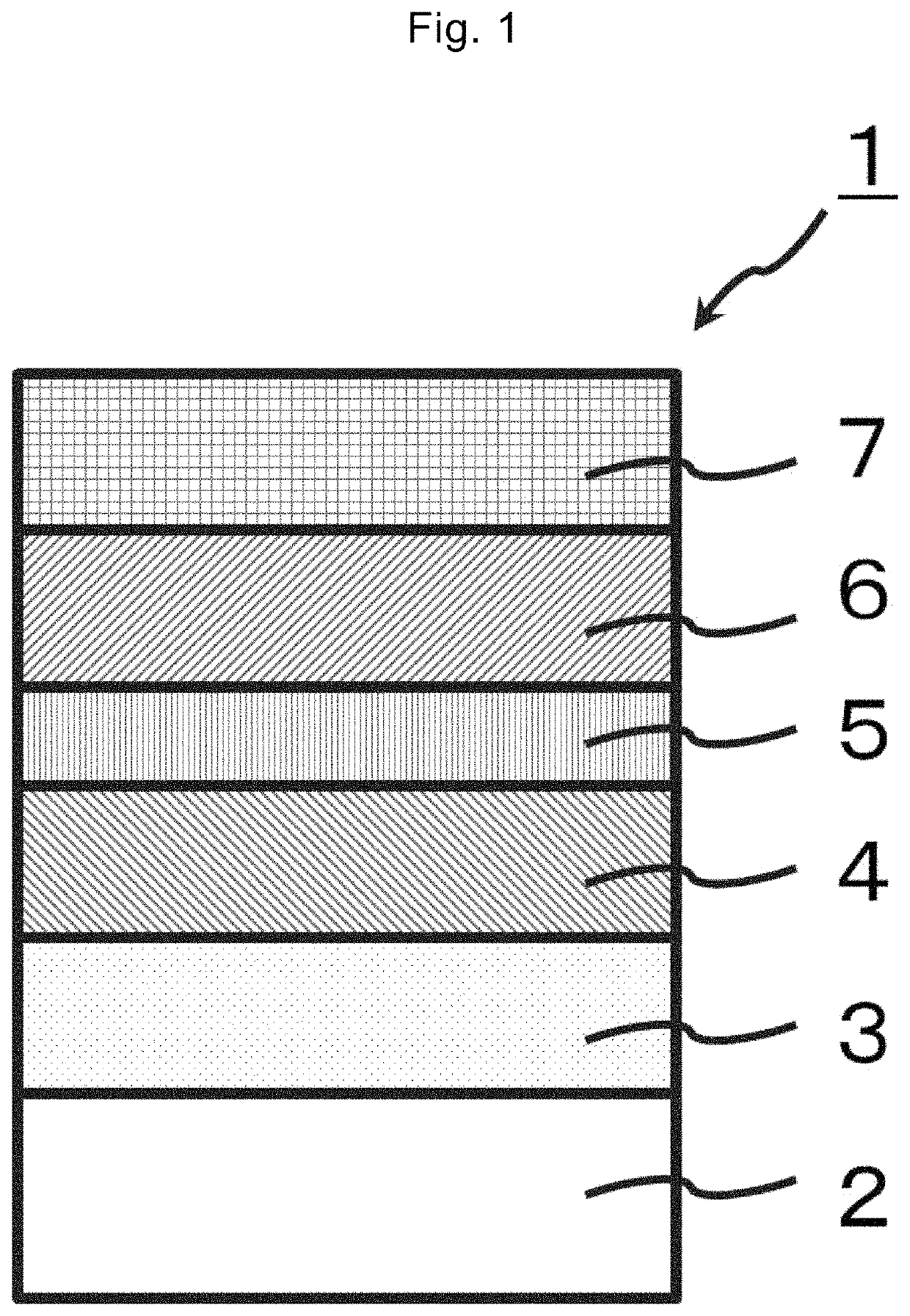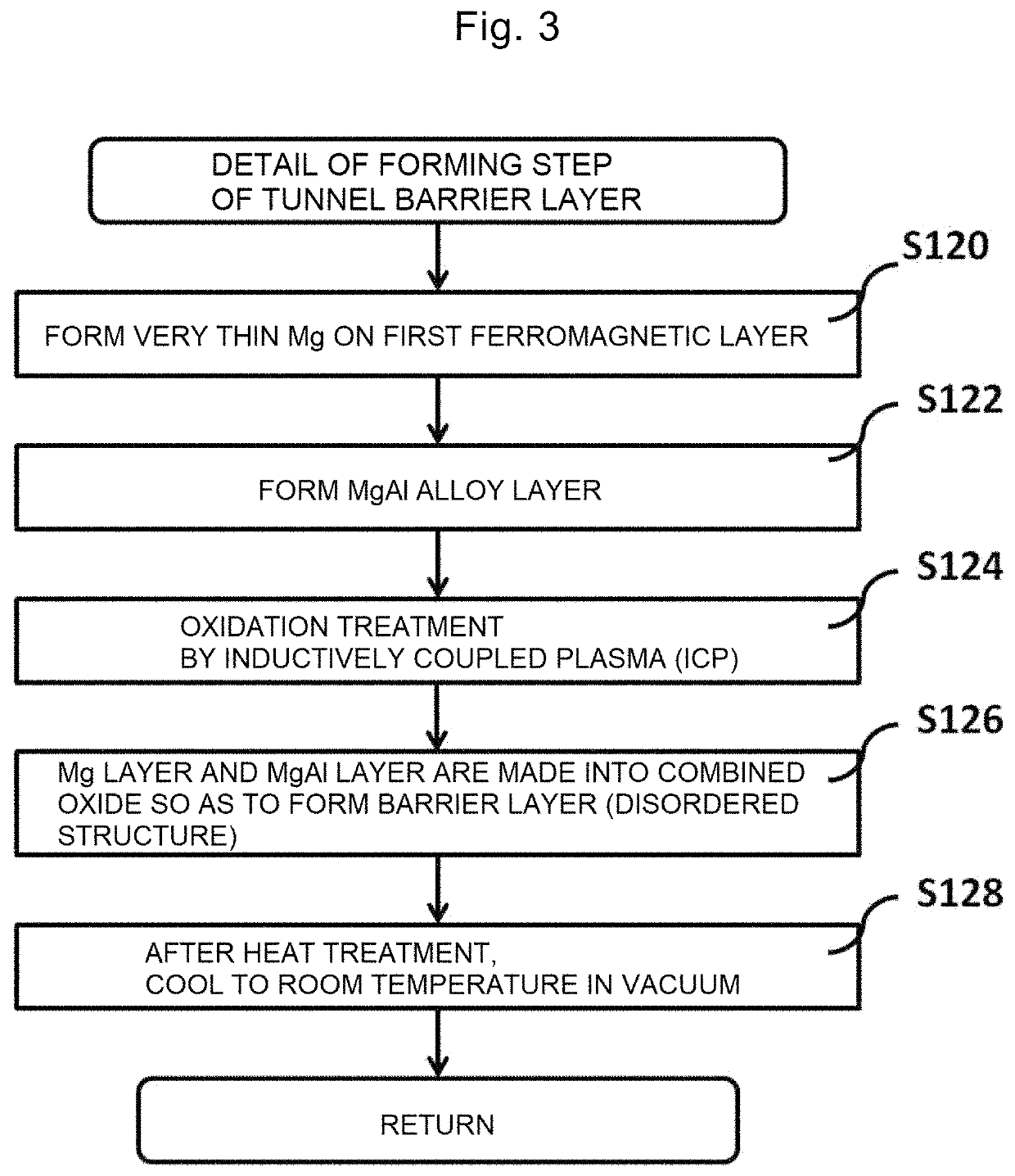Magnetic tunnel junction, magnetoresistive element and spintronics device in which said magnetic tunnel junction is used, and method of manufacturing magnetic tunnel junction
a technology of magnetoresistive elements and magnetic tunnel junctions, which is applied in the field of magnetic tunnel junctions, magnetoresistive elements and spintronics devices in which the magnetic tunnel junction is used, and the method of manufacturing magnetic tunnel junctions, can solve the problems of difficult to draw tmr characteristics, difficult to change, and limited ferromagnetic layer materials, etc., to achieve efficient manufacturing of mtj elements, high tmr ratio, and large tmr ratio
- Summary
- Abstract
- Description
- Claims
- Application Information
AI Technical Summary
Benefits of technology
Problems solved by technology
Method used
Image
Examples
example 1
[0064]Firstly, a method of manufacturing a Co-based Heusler alloy layer, which is the second ferromagnetic layer 6, adjacently on a spinel MgAl2O4 layer, which is the barrier layer 5, will be shown with reference to FIG. 4. As an example of the Co-based Heusler alloy layer, a case of a Co2FeAl layer will be described. Using an ultrahigh vacuum direct current magnetron sputtering apparatus, a Cr layer (40 nm) was manufactured as an underlayer on a single crystal MgO (001) substrate at a room temperature. For improving crystallinity and flatness, the Cr layer was treated by heat at 500° C. in a vacuum chamber for 1 hour after it was formed, and then was cooled to a room temperature. Thereon, a CoFe layer (10 nm) was manufactured from a Co50Fe50 composition target by sputtering, was subsequently treated by heat at 250° C. in a vacuum chamber for 15 minutes, and was cooled to a room temperature.
[0065]Subsequently, Mg (0.45 nm) was formed at a room temperature, and this laminated film wa...
example 2
[0070]Next, an example of forming an MTJ element by applying the method shown in Example 1 will be described with reference to FIG. 5.
[0071]Using the same ultrahigh vacuum direct current magnetron sputtering apparatus as that in Example 1, a film having two layers of Cr (40 nm) / CoFe (5 nm) was manufactured as an underlayer on a single crystal MgO (001) substrate at a room temperature. After the formation of the Cr layer, heat treatment was carried out at 500° C. in vacuum. Thereon, Co2FeAl (5 nm) was manufactured as the first ferromagnetic layer by sputtering in the same method as that in Example 1. Thereafter, the Co2FeAl film was treated by heat at 250° C. similarly to the underlayer in order to improve the crystallinity of the Co2FeAl film, and was cooled to a room temperature. Subsequently, Mg (0.45 nm) was formed at a room temperature, and this laminated film was moved into a chamber for oxidation. Subsequently, a layer of Mg (0.45 nm) / MgAl alloy (0.75 nm) was formed in the sam...
example 3
[0075]Next, an example of forming an MTJ element by applying the method described in Example 2 so as to improve a TMR ratio will be described with reference to FIGS. 6 to 9. Using the same apparatus and method as those in Example 2, a multilayer film of Cr (40 nm) / CoFe (5 nm) / lower Co2FeAl (5 nm) was formed on an MgO (001) substrate. Thereafter, a CoFe layer of 0.5 nm was formed by a direct current sputtering method. Immediately thereafter, the film was treated by heat at 250° C. in vacuum for 15 minutes, and was cooled to a room temperature. Subsequently, an MgAl2O4 barrier layer and an upper Co2FeAl layer were formed by the same method as those in Examples 1 and 2, and were treated by heat at a temperature of TCFA=550° C. in vacuum. After cooling to a room temperature, a laminated film of CoFe (0.5 nm) / IrMn (12 nm) / Ru (10 nm) was formed as an upper electrode layer by the same method as that in Example 2, thereby manufacturing a spin valve-type MTJ element. Then, after carrying out...
PUM
| Property | Measurement | Unit |
|---|---|---|
| lattice constant | aaaaa | aaaaa |
| thickness | aaaaa | aaaaa |
| thickness | aaaaa | aaaaa |
Abstract
Description
Claims
Application Information
 Login to View More
Login to View More - R&D
- Intellectual Property
- Life Sciences
- Materials
- Tech Scout
- Unparalleled Data Quality
- Higher Quality Content
- 60% Fewer Hallucinations
Browse by: Latest US Patents, China's latest patents, Technical Efficacy Thesaurus, Application Domain, Technology Topic, Popular Technical Reports.
© 2025 PatSnap. All rights reserved.Legal|Privacy policy|Modern Slavery Act Transparency Statement|Sitemap|About US| Contact US: help@patsnap.com



